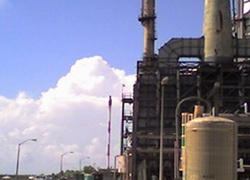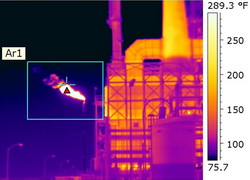
-
Application Stories
• Building
• Furnace and Boiler Tube Inspection
• Medical
Flare Gas Monitoring Systems
Flare stacks are used in many industries to burn off unwanted waste gas byproducts, or flammable gases released by pressure relief valves during unplanned over-pressuring of plant equipment.
Applications include oil and gas well drilling operations, oil refineries, chemical process plants, gas distribution infrastructure, and landfills. In many cases, federal or state EPA regulations require the monitoring of a stack's flame, or the pilot flame that ignites the gases, to avoid having unburned hydrocarbons enter the atmosphere. IR video cameras are an ideal monitoring tool, since they allow automated remote monitoring on a 24/7 basis in virtually any weather. In addition, IR cameras avoid many of the technical and cost-related problems associated with other technologies such as ultraviolet (UV) flame detectors, flame ionization spectrometers, thermocouples, and pyrometers.
AVOID AIRBORNE POLLUTANTS
• Verify combustion, minimize unburned pollutants
• Instantly report loss of combustion with visual and audible alarms
• Remote visual monitoring with a TV or PC display
• Provides a quantitative temperature readout
• Notify plant management via email and intranet connections
• Camera connections to a central control room via Ethernet
• Works day or night in any weather – 24/7 operation
Flaring is a Complex Process
Flare systems are often a last line of defense that prevents dangerous hydrocarbon pollutants from entering the atmosphere. One example is methane, which is not only combustible, but is also 23 times more potent than CO2 as a greenhouse gas. A plant manager needs to know immediately if flare stack combustion is lost, and get the flame reignited quickly to prevent a plant shutdown.
Various technologies have been tried for monitoring the pilot flame that ignites gas flow and detects the stack flame, with varying degrees of success. Many of these technologies are useless or poor at monitoring smoke from stake combustion, an important indicator of burn efficiency. One of the problems is that flare gas flows can range from low volumes during fuel gas purges in normal operations, to very large flows during emergency relief valve dumps or during total plant blowdowns. The size and brightness of the resulting stack flame, and the amount of smoke generated, depends on how much flammable material is released. Assist gases such as air or steam may be injected into the gas flow to improve combustion and help minimize smoke.


FLIR IR Camera Solution
FLIR IR cameras recognize the difference in the heat signature of a flare stack flame and the surrounding background (usually, the sky or clouds). In addition to detecting stack flame, these cameras can be positioned to monitor the igniter flame. Typically, cameras are mounted on a pedestal or other rigid structure in moisture resistant housings to protect them from harsh weather conditions. The camera's spectral response and calibration allows it to see through moisture in the air to obtain a good image and relative temperature reading of the flare stack or pilot flame.The images obtained with FLIR IR cameras allow an observer to detect stack flame that might not be visible to the naked eye because of its composition or low gas flow volume. This overcomes problems associated with UV flame detectors, which can be blinded by smoke. However, since the EPA considers excessive smoke an indication of poor combustion, IR cameras may be integrated with visual video cameras to monitor smoke. Thermographic and visual images can be transmitted in real time to a central control room as either analog or digitized data.
- Home
- |
- Products
- |
- Training
- |
- Application |
- Image Gallery |
- Contact Us
Copyright ©2012 - Thermoscan Co., Ltd. - All Rights Reserved.
Thermoscan Co., Ltd. (บริษัท เทอร์โมสแกน จำกัด)
731 PM Tower, 5th Floor, Asok Dindaeng Road, Dindaeng, Dindaeng, Bangkok 10400
Tel: (02) 642-9489 Fax: (02) 642-9424
E-mail: tms@thermoscan.co.th
